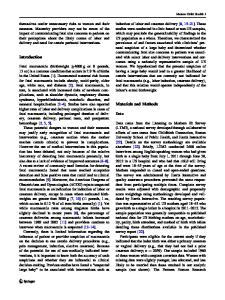Which is better for mothers and babies: fresh or frozen-thawed blastocyst transfer?
- PDF / 4,823,264 Bytes
- 20 Pages / 595.276 x 790.866 pts Page_size
- 77 Downloads / 274 Views
(2020) 20:559
RESEARCH ARTICLE
Open Access
Which is better for mothers and babies: fresh or frozen-thawed blastocyst transfer? Meiling Yang1,2, Li Lin1,3, Chunli Sha1,3, Taoqiong Li1,3, Wujiang Gao1,3, Lu Chen1,3, Ying Wu1,3, Yanping Ma1,3 and Xiaolan Zhu1,3*
Abstract Background: In recent years, there have been many reports on the pregnancy outcomes of fresh blastocyst transfer (BT) and frozen-thawed BT, but the conclusions are controversial and incomplete. To compare the pregnancy outcomes, maternal complications and neonatal outcomes of fresh and frozen-thawed BT in the context of in vitro fertilization or intracytoplasmic sperm injection (IVF/ICSI) cycles, we conducted a meta-analysis. Methods: A meta-analysis was conducted by searching the PubMed, Embase, and Cochrane Library databases through May 2020. Data were extracted independently by two authors. Results: Fifty-four studies, including 12 randomized controlled trials (RCTs), met the inclusion criteria. Fresh BT was associated with a lower implantation rate, pregnancy rate, ongoing pregnancy rate, and clinical pregnancy rate and higher ectopic pregnancy rate than frozen-thawed BT according to the results of the RCTs. The risks of moderate or severe ovarian hyperstimulation syndrome, placental abruption, placenta previa and preterm delivery were higher for fresh BT than for frozen-thawed BT. The risk of pregnancy-induced hypertension and pre-eclampsia was lower for fresh BT; however, no significant differences in risks for gestational diabetes mellitus and preterm rupture of membrane were found between the two groups. Compared with frozen-thawed BT, fresh BT appears to be associated with small for gestational age and low birth weight. No differences in the incidences of neonatal mortality or neonatal malformation were observed between fresh and frozen-thawed BT. Conclusions: At present there is an overall slight preponderance of risks in fresh cycles against frozen, however individualization is required and current knowledge does not permit to address a defintive response. Keywords: Fresh blastocyst transfer, Frozen-thawed blastocyst transfer, Pregnancy outcome, Maternal complications, Neonatal outcomes
* Correspondence: [email protected] 1 Reproductive Medicine Center, The Fourth Affiliated Hospital of Jiangsu University (Zhenjiang Maternal and Child Health Hospital), 20 Zhengdong Road, Zhenjiang, Jiangsu 212001, People’s Republic of China 3 Reproductive Sciences Institute, Jiangsu University, Zhenjiang 212001, Jiangsu, China Full list of author information is available at the end of the article © The Author(s). 2020 Open Access This article is licensed under a Creative Commons Attribution 4.0 International License, which permits use, sharing, adaptation, distribution and reproduction in any medium or format, as long as you give appropriate credit to the original author(s) and the source, provide a link to the Creative Commons licence, and indicate if changes were made. The images or other third party material in this article are included in the article
Data Loading...











